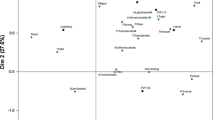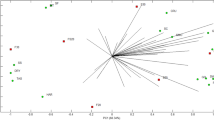Abstract
This study was conducted to investigate whether the saltiness of naengmyeon (NMS) and onmyeon soups (OMS) could be influenced by the addition of vinegar. The NMS samples were prepared by adding NaCl (at 0.25-1.0%) and v inegar (at 0, 0.5, or 1.0%) to cold beef s tock (10°C). Perceived saltiness was assessed by 41 panelists using a generalized labeled magnitude scale. The OMS samples were prepared by adding NaCl (at 0.5 or 1.0%) and vinegar (at 0.03-0.15%) to hot beef stock (60°C). Perceived saltiness was assessed using a two-alternative forced choice test with 56 panelists. Vinegar significantly increased the saltiness of NMS with 0.25 and 0.5% NaCl, but suppressed the saltiness of those with 0.75 and 1.0% NaCl. In the OMS samples, vinegar significantly enhanced the saltiness of soups with 0.5% NaCl, but the saltiness of those with 1.0% NaCl was enhanced only by 0.15% vinegar.
Similar content being viewed by others
References
Hong SM, Lee JH, Kim HK, Yu R, Seo JH, Huh EJ, Cho SS, Yang J. Study on sodium reduction: 'Heathy restaurant for sodium reduction'. J. Korean Diet. Assoc. 20: 174–182 (2014)
Dötsch M, Busch J, Batenburg M, Liem G, Tareilus E, Mueller R, Meijer G. Strategies to reduce sodium consumption: A food industry perspective. Crit. Rev. Food Sci. 49: 841–851 (2009)
Meneton P, Jeunemaitre X, de Wardener HE, Macgregor GA. Links between dietary salt intake, renal salt handling, blood pressure, and cardiovascular diseases. Physiol. Rev. 85: 679–715 (2005)
Mozaffarian D, Fahimi S, Singh GM, Micha R, Khatibzadeh S, Engell RE, Lim S, Danaei G, Ezzati M, Powles J. Global sodium consumption and death from cardiovascular causes. New Engl. J. Med. 371: 624–634 (2014)
Ministry of Food and Drug Safety. Food & Drug Statistical Yearbook. 16th ed. Ministry of Food and Drug Safety, Seoul, Korea. pp. 488–520 (2014)
Song DY, Park JE, Shim JE, Lee JE. Trends in the major dish group and food groups contributing to sodium intake in the Korea national health and nutrition examination survey 1998–2010. Korean J. Nutr. 46: 72–85 (2013)
Despain D. Easy steps to less salt. Food Technol.-Chicago 68: 48–59 (2014)
Nachay K. Moving toward on sodium reduction. Food Technol.-Chicago 67: 35–45 (2013)
Breslin PAS. Interactions among salty, sour and bitter compounds. Trends Food Sci. Tech. 7: 390–399 (1996)
Liem DG, Miremadi F, Keast RSJ. Reducing sodium in foods: The effect on flavor. Nutrients 3: 694–711 (2011)
Hatae K, Takeutchi F, Sakamoto M, Ogasawara Y, Akano H. Saltiness and acidity: Detection and recognition thresholds and their interaction near the threshold. J. Food Sci. 74: S147–S153 (2009)
Keast RJS, Breslin PAS. An overview of binary taste-taste interactions. Food Qual. Prefer. 14: 111–124 (2003)
Pangborn RM, Chrisp RB. Taste interrelationships. VI. sucrose, sodium chloride, and citric acid in canned tomato juice. J. Food Sci. 29: 490–498 (1964)
Pangborn RM, Trabue IM. Taste interrelationships. V. sucrose, sodium chloride, and citric acid in Lima bean puree. J. Food Sci. 29: 233–240 (1964)
Hellemann U. Perceived taste of NaCl and acid mixtures in water and bread. Int. J. Food Sci. Tech. 27: 201–211 (1992)
Kang MW, Chung SJ, Lee HS, Kim Y, Kim KO. The sensory interactions of organic acids and various flavors in ramen soup systems. J. Food Sci. 72: S639–S647 (2007)
Nasri N, Spetier C, Beno N, Salles C, Thomas-Danguin T. Enhancing salty taste through odour-taste-taste interactions: Influence of odour intensity and salty tastants’ nature. Food Qual. Prefer. 28: 134–140 (2013)
Green BG, Shaffer GS, Gilmore MM. Derivation and evaluation of a semantic scale of oral sensation magnitude with apparent ratio properties. Chem. Senses 18: 683–702 (1993)
Green BG, Dalton P, Cowart B, Shaffer G, Rankin K, Higgins J. Evaluating the 'labeled magnitude scale' for measuring sensations of taste and smell. Chem. Senses 21: 323–334 (1996)
Bartoshuk LM, Fast K, Snyder DJ. Dif ferences in our sensory worlds: Invalid comparisons with labeled scales. Curr. Dir. Psychol. Sci. 14: 122–125 (2005)
Meilgaard M, Civille GV, Carr BS. Attribute difference tests: How does attribute X differ between samples? pp. 99–121. In: Sensory evaluation techniques. 3rd ed. CRC Press, Inc., Boca Raton, FL, USA (1999)
Jung DW, Hong JH, Kim KO. Sensory characteristics and consumer acceptability of beef soup with added glutathione and/or MSG. J. Food Sci. 75: S36–S42 (2010)
Hong JH, Jung DW, Kim YS, Lee SM, Kim KO. Impact of glutathione maillard reaction products on sensory characteristics and consumer acceptability of beef soup. J. Food Sci. 75: S427–S434 (2010)
Shin ME, Lee KH. Study on appropriate mixing ratios of various animal meats with other ingredients to improve the palatability of stock. J. Korean Soc. Food Cult. 26: 409–415 (2011)
Fujimaru T, Park JH, Lim J. Sensory characteristic and relative sweetness of tagatose and other sweeteners. J. Food Sci. 77: S323–S328 (2012)
Koo TY, Kim KO, O'Mahony M. Effects of forgetting on performance on various intensity scaling protoclols: Magnitude estimation and labeled magnitude scale (Green scale). J. Sens. Stud. 17: 177–192 (2002)
Meilgaard M, Civille GV, Carr BS. Statistical tables. pp. 351–375. In: Sensory Evaluation Techniques. 3rd ed. CRC Press, Inc., Boca Raton, FL, USA (1999)
Cambero MI, Pereira-Lima CI, Ordoñez JA, García Fernando GD. Beef broth flavour: Study of flavour development. J. Sci. Food Agr. 80: 1510–1518 (2000)
Jarboe JK, Mabrouk AF. Free amino acids, sugars, and organic acids in aqueous beef extract. J. Agr. Food Chem. 22: 787–791 (1974)
Lawless HT, Heymann H. Physiological and Psychological Foundations of Sensory Function. pp. 19–56. In: Sensory Evaluation of Food: Principles and Practices. 2nd ed. Springer Science Inc., New York, NY, USA (2010)
Green BG, Lim J, Osterhoff F, Blacher K, Nachtigal D. Taste mixture interactions: Suppression, additivity, and the predominance of sweetness. Physiol. Behav. 101: 731–737 (2010)
Prescott J, Ripandelli N, Wakeling I. Binary taste mixture interactions in PROP non-tasters, medium-tasters and super-tasters. Chem. Senses 26: 993–1003 (2001)
Wilkie LM, Phillips EDC. Heterogeneous binary interactions of taste primaries: Perceptual outcomes, physiology, and future directions. Neurosci. BioBehav. R. 47: 70–86 (2014)
Author information
Authors and Affiliations
Corresponding author
Rights and permissions
About this article
Cite this article
Ko, J., Cho, M.H., Shim, J. et al. Effect of vinegar on the perceived saltiness of naengmyeon and onmyeon soup systems. Food Sci Biotechnol 24, 1695–1701 (2015). https://doi.org/10.1007/s10068-015-0220-y
Received:
Revised:
Accepted:
Published:
Issue Date:
DOI: https://doi.org/10.1007/s10068-015-0220-y




